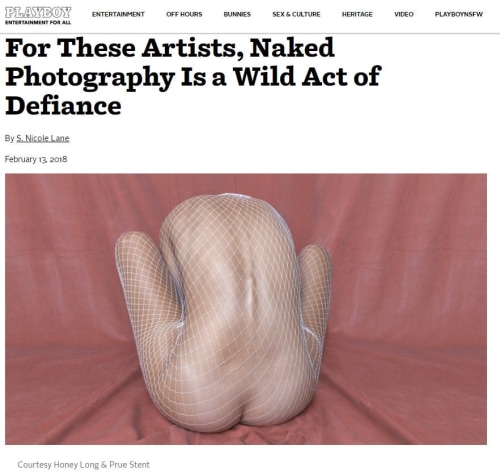
Collaboration is where the magic happens in the art world. So when most prominent female photographers–Amanda Charchian, Remy Holwick, duo Honey Long and Prue Stent, and Magdalena Wosinska–came together to create the Future Feminine, it demonstrably resulted in a spectacularly moving display. While the name may immediately draw visions of the ever-popular, twee t-shirt that states “The future is female,” this is a far more complex exploration of the effects of a world dominated by the male gaze.
Two participating artists who push boundaries and challenge the status quo include creative partners, Honey Long and Prue Stent. Both hail from Australia and focus on photography, where mediums such as performance, fashion, installation, and sculpture are intertwined into their overall vision. The duo is drawn to themes of femininity and how it can be associated with passivity. They challenge this passive stereotype by obscuring and manipulating identity. Through their lens, Long and Stent focus on femininity as a powerful force–a palette of surreal landscapes, soft bodies draped in fabrics and coiled into abstraction. After five years of collaboration, the 24-year-old pair again prove the power of shared visions: “Our first creative project together was doodling on t-shirts with fabric markers and labelling them as ‘Prue and Honey productions’.”
Frequenting thrift stores and dressing up in handmade costumes was how they spent their early friendship which began in high school. “That’s pretty much what our art practice evolved from, a lot of play.” That element of playfulness is still visible in their current ouvre: Figures are seen reacting to one another through body-hugging fabrics on tenacious figures, and an intimate relationship to natural surroundings. “In a lot of ways, it feels like the skin of our cultural psyche that we all choose to cover ourselves with in different ways,” they explain. In many images, the fabric ignites a life of its own; moving with the wind, or clinging and following curves.
“‘The feminine’ feels like this big water balloon that has come to hold so many different ideas pertaining to ways of being–some distinct to race, sex, sexuality and some completely separate from it. Hopefully in the future it will have burst and all those different ideas will have dispersed into a web of interactions rather than trying to classify and prescribe ways of being to a specific gender,” Long and Stent elaborate. So much of their work examines and dismantles the idea of sex or gender. Of course, stereotypes run rampant through any image with a female-identifying figure. But the duo hopes to “break the surface of the image for the viewer,” while also celebrating the relationship that they share to their own bodies.
On the same walls in Fahey/Klein Gallery hangs Magdalena Wosinska’s own artistic panorama on the same subject. In contrast, the Polish artist refuses to recognize the separation between the male and female gazes. “We are just people taking photos and documenting life—male or female gaze—it’s a photographer’s eye,” she says. For Wosinska, her images are raw, fleeting and encapsulated by the gritty results of intimacy, love and human relationships.
Wosinska’s photography is shot under ambient light—particularly under the sun-drenched environment of her home, California—giving her body of work a snapshot approach where she captures the lives of friends and strangers that she meets on the road, in the water, or in bed. Woskinska says about her practice: “I’m addicted, I love it.” For her personal work, she shoots on film and for clients it’s mostly digital. “Nudity is timeless,” says Wosinska. “And I live as many intimate moments as most people, the only difference is I photograph those moments while living them.“
Wosinska began photographing skateboard culture when she was 14 and for 10 years on. After ruminating on the evolution of an artist, she clarifies, “I would not just shoot skate photos but photos of people just hanging in the skate scene in the US during the late ‘90s early 2000s. Then I started playing in a metal band called Green & Wood for almost 7-8 years.” She continues, “I was always interested in photographing my surroundings. And as I have gotten older my surroundings have changed and what I’m amused by has as well. My muse now is my elderly mother. It’s a very special time for me to be photographing her.” The models in Wosinska’s images seem at ease; they are au natural and candid. She focuses in on what she reads of people–their insecurities and strengths–in order to attain a rarer vision of the given subjects. “I want to shoot people for who they are not for what they pose to be,” she says.
Although Long, Stent and Wosinska’s images are vastly different on a superficial level, they all work to ignite the unencumbered version of a woman–the woman who doesn’t doubt herself under the magnifying glass that is societal gender norms. The definition of “femininity” includes adjectives such as “pretty” and “delicate” (synonyms for "weak” and “fragile”), but these women viscerally demonstrate a future where feminine is anything but flimsy.